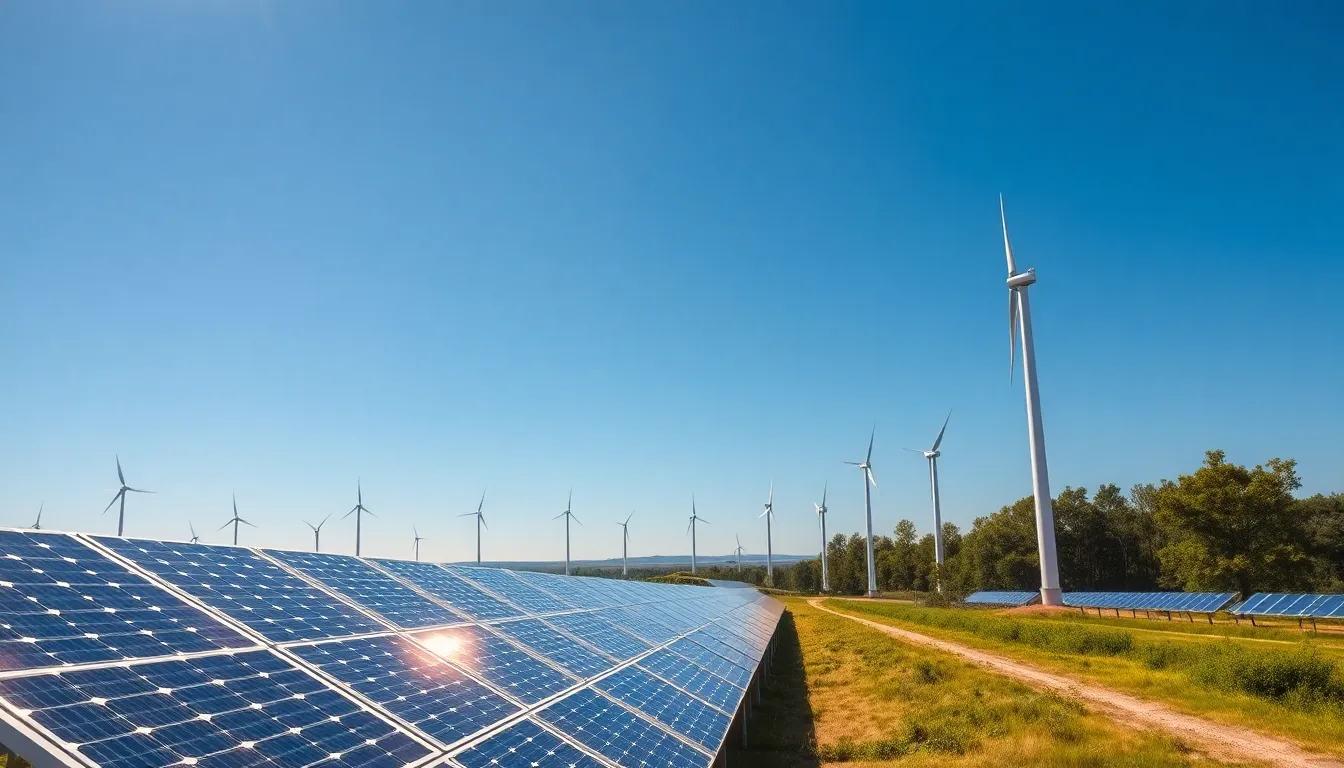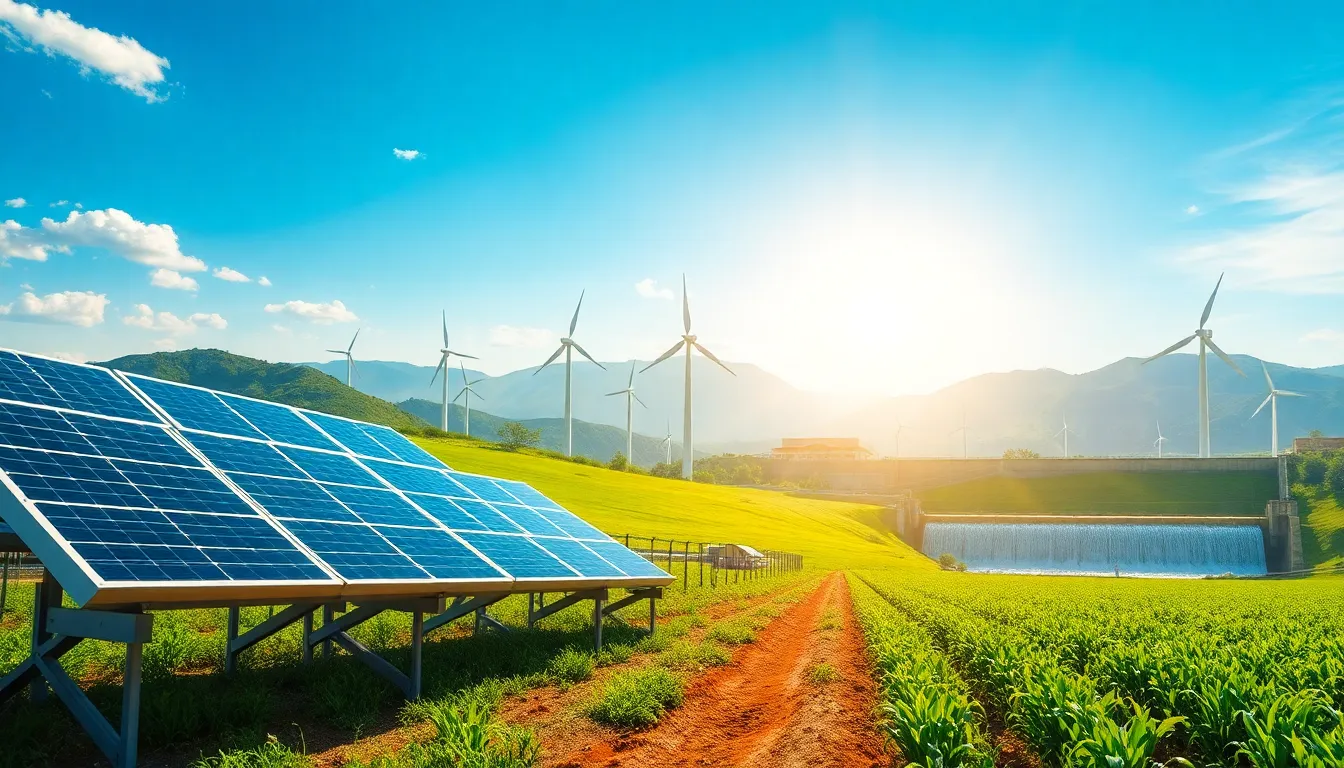In a world where the sun shines brighter than your neighbor’s new sports car and the wind blows like it’s auditioning for a role in a blockbuster movie, green energy is stealing the spotlight. It’s not just a trend; it’s a revolution that promises to power our lives without leaving a smoky trail behind. Imagine harnessing the sun’s rays or the wind’s whispers to fuel your daily grind—sounds like something out of a sci-fi flick, right?
But this isn’t a fantasy; it’s the future, and it’s here now. As climate change looms like a bad hangover, embracing green energy isn’t just smart; it’s essential. So, buckle up and get ready to explore the electrifying world of renewable resources that could turn the tide for our planet while keeping your energy bills in check. Who knew saving the Earth could be this much fun?
Table of Contents
ToggleOverview Of Green Energy
Green energy refers to power derived from renewable sources that naturally replenish over time. Solar, wind, hydroelectric, and geothermal energy exemplify these sustainable resources. Using these alternatives reduces reliance on fossil fuels, thereby lowering greenhouse gas emissions and promoting environmental sustainability.
Solar energy harnesses sunlight through photovoltaic cells or solar panels. This technology converts sunlight into electricity, making it an accessible option for homeowners and businesses. Wind energy captures the kinetic energy of wind using turbines, proving effective in various geographical locations.
Hydroelectric power generates electricity through flowing water. Dams typically store water in reservoirs, releasing it to turn turbines. Geothermal energy exploits heat from the Earth’s interior, providing consistent energy regardless of weather conditions.
Green energy contributes significantly to the global economy. Jobs in the renewable energy sector have increased by 11.5 million since 2018, showcasing its potential for economic growth. Transitioning to green energy also decreases energy costs over time, leading to long-term savings for consumers.
Countries around the world are investing in green energy initiatives. For instance, the United States aims for 50% of its electricity to come from renewable sources by 2030. This ambitious goal reflects a global shift toward sustainable energy solutions and a commitment to combating climate change.
Adoption of green energy enhances energy security. Utilizing local, renewable resources reduces dependence on imported fossil fuels, building resilience against geopolitical tensions. The movement toward green energy represents a vital step toward achieving a sustainable future for generations to come.
Types Of Green Energy


Green energy comes from renewable resources that replenish naturally. Various types include solar power, wind energy, hydropower, and biomass energy, each contributing to sustainability and reducing carbon footprints.
Solar Power
Solar power harnesses sunlight through solar panels to generate electricity. The technology converts solar energy into usable power, significantly decreasing reliance on fossil fuels. In 2022, the U.S. solar industry grew by 19% and created many new jobs. Such growth illustrates the sector’s potential. Every installation contributes to lower greenhouse gas emissions. Many homeowners and businesses benefit from solar energy due to reduced energy costs over time.
Wind Energy
Wind energy utilizes wind turbines to convert wind flow into electricity. Turbines rotate as wind passes, generating clean energy efficiently. In 2023, wind energy accounted for nearly 9% of the total electricity generated in the U.S. The technology is scalable, making it suitable for both small and large projects. States like Texas and Iowa lead in wind energy production, showcasing its viability. Each wind farm contributes significantly to reducing carbon emissions.
Hydropower
Hydropower relies on flowing water to create energy, often using dams. Water flow spins turbines, which generate electricity. This renewable source provides approximately 30% of the world’s renewable electricity supply. Many countries invest in hydropower due to its efficiency. Various projects range from large-scale dams to small run-of-the-river installations. Hydropower also plays a crucial role in balancing energy needs, making it a dependable resource.
Biomass Energy
Biomass energy originates from organic materials like plants and waste. When burned or converted, these materials release energy that can produce electricity and heat. Biomass contributes about 5% of the total energy consumption in the U.S., providing an alternative to fossil fuels. Various types of biomass, including agricultural residues and wood pellets, ensure a diverse range of energy sources. As waste materials are utilized, biomass energy promotes sustainability and reduces landfill usage.
Benefits Of Green Energy
Green energy offers numerous advantages that extend beyond environmental improvements. Its impact on society, the economy, and energy security highlights the importance of adopting renewable resources.
Environmental Impact
Green energy significantly reduces greenhouse gas emissions. Solar panels and wind turbines produce electricity without harmful pollutants. This transition lessens the negative effects of climate change. Renewable resources also preserve biodiversity by minimizing habitat destruction. Utilizing geothermal energy and hydropower further protects ecosystems and water sources. The commitment to green energy enhances air quality, leading to better public health outcomes. Transitioning to renewables addresses the urgent need for sustainable practices.
Economic Advantages
Green energy contributes to economic growth through job creation. The sector added 11.5 million jobs since 2018, with many opportunities across various regions. Investments in renewable technologies also stimulate local economies. For instance, companies engaged in solar energy installation and wind farm development generate significant revenue. Additionally, green energy reduces electricity costs over time. As technology advances, efficiency improves, leading to lower consumer bills. Supporting green energy development strengthens economies while encouraging innovation.
Energy Independence
Green energy fosters energy independence for nations. By harnessing local resources, countries reduce reliance on imported fossil fuels. This shift leads to enhanced energy security and stability. Utilizing solar and wind energy diversifies the energy supply, mitigating risks associated with foreign dependency. A focus on renewables encourages investment in domestic infrastructure. Developing this sector ultimately supports national security and creates resilient energy systems. Embracing green energy empowers nations to make sustainable and self-sufficient choices.
Challenges Facing Green Energy
Green energy faces several challenges that can hinder its growth and effectiveness. Addressing these obstacles is crucial for the sector’s advancement.
Technological Limitations
Technological limitations slow the transition to green energy. Current renewable technologies, such as solar panels and wind turbines, require ongoing development for improved efficiency. Energy storage solutions, like batteries, remain expensive and often lack sufficient capacity for large-scale use. Moreover, intermittency issues present challenges, as solar and wind resources are not available all the time. Innovations in energy management systems and grid integration are necessary to overcome these hurdles.
Policy and Regulatory Issues
Policy and regulatory issues significantly impact the green energy landscape. Inconsistent regulations across regions create uncertainty for investors and developers. Some governments may lack supportive policies that incentivize renewable energy projects, resulting in financial constraints. Moreover, outdated energy infrastructure can impede the integration of renewable resources into existing grids. Stronger government commitment and updated regulations can help stimulate the growth of the green energy sector, fostering a more sustainable future.
Future Of Green Energy
Renewable energy technologies will increasingly advance, leading to higher efficiency and lower costs. Solar and wind energy stand out due to their rapid scalability and affordability. Data shows that capacity for solar power has increased by 167% from 2018 to 2023, influencing their adoption.
Policy changes play a crucial role in this sector’s evolution. Governments are establishing stricter emissions standards and providing incentives to promote renewable sources. For instance, the U.S. aims for 50% of its electricity generation to come from renewables by 2030, reflecting a strong commitment to sustainability.
Investment in green energy technologies is likely to surge. Experts project global investments in renewables to reach $2 trillion annually by 2030, further supporting the industry’s expansion. Keeping pace with this growth, energy storage solutions, such as advanced battery technologies, will ensure reliable power supply despite the intermittent nature of solar and wind resources.
Community involvement is essential for the success of green energy initiatives. Local governments can collaborate with residents to implement projects like community solar farms. Such collaborations maximize accessibility and promote local job creation.
Future trends indicate increased integration of green energy into existing infrastructure. Smart grid technologies can enhance energy management and efficiency. By leveraging artificial intelligence, predictive analytics can optimize energy consumption and distribution.
New job opportunities continue to emerge, providing significant economic benefits. The renewable energy sector has created 11.5 million jobs since 2018, highlighting its potential for further employment growth. As clean energy becomes more mainstream, workforce training programs will be necessary to prepare workers for these new roles.
Overall, the future of green energy promises to be transformative, emphasizing environmental sustainability and economic growth.




